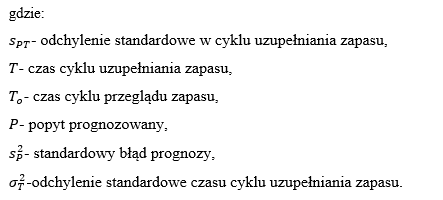
Prediction intervals as quantification of predictions using a neural network
15 February 2022
Prospects for the application of LSTM and GRU neural networks in supply chain management
17 March 2022

Prediction intervals as quantification of predictions using a neural network
15 February 2022
Prospects for the application of LSTM and GRU neural networks in supply chain management
17 March 2022The essence and importance of collateral inventory and its implications with demand forecast errors

Collateral inventory is held to protect against demand volatility (demand deviations from forecasts) and variability in replenishment cycle time. The right level Safety stock avoids a stock-out situation in the event of an unexpected increase in demand or an extended delivery cycle [1]. The necessary information to determine the safety stock is [2]:
- Estimate the standard deviation of the demand forecast error in the sPT replenishment cycle. To determine it, it is necessary to know:
- Forecasts of the average value of demand P,
- Standard deviation of forecast error s,
- expected replenishment cycle time T,
- The standard deviation of the replenishment cycle time σT.
- The required level of service, which can be determined from [2]:
- experiences,
- literature data,
- comparisons with competitors,
- specific requirements of recipients,
- optimization calculus with knowledge of inventory holding costs and the cost of inventory shortage.
- Adopted stock renewal method.
The safety stock, in the basic model, is determined according to the formula [3]:
ZB = ω • sPT
Where:
ω – safety factor depending on the level of service adopted and the type of frequency distribution of demand volume,
sPT – variability (standard deviation) demand forecast error in the replenishment cycle.
The value of sPT depends on the variability of demand (demand) and the variability of the replenishment cycle time. To correctly calculate the safety stock, the following parameters must also be taken into account:
1. if there is variable demand (sP > 0) and a fixed (recurring) replenishment cycle time (σT=0) then:![]()
2. If there is a constant demand (sP = 0) and variable time of the replenishment cycle (σT > 0) then:
![]() 3. If demand and replenishment cycle time are variable then:
3. If demand and replenishment cycle time are variable then:
![]()

As can be seen from the above formulas, the size of the forecast error implies the level of the hedging stock. Forecasting methods based on deep neural networks can therefore reduce the level of safety stock when forecast accuracy is improved.
The safety stock belongs to the non-rotating part of the total inventory and is by all means necessary for the proper functioning of the company’s inventory management. The rotating part, in turn, is the stock provided to meet current demand. A proper inventory structure should include a non-rotating portion, which is should constitute only the safety stock and the rotating part (cyclical stock). However, in many cases, non-rotating stock includes operational excess stock. From the point of view of current needs taking into account reasonable hedging against higher than expected demand and/or against delayed delivery, it is not justified. Its presence in the inventory structure may explain speculative buying (e.g., resulting from information about planned price increases). Otherwise, excess inventory should be considered an unjustified investment that generates costs without the expected added value.
Literature:
- Cyplik P., Zastosowanie klasycznych metod zarządzania zapasami do optymalizacji zapasów magazynowych – Case Study, LogForum, 2005, vol 1. Issue 3, no. 1
- Krzyżaniak S.: Podstawy zarządzania zapasami w przykładach, Wydanie III, Instytut Logistyki i Magazynowania, Poznań, 2005
- Krzyżaniak S., Cyplik P., Zapasy i magazynowanie Tom I: Zapasy – Podręcznik do kształcenia w zawodzie technik logistyk, Biblioteka Logistyka, Poznań, 2007
This article was written thanks to the funds from the European Union’s co-financing of the Operational Program Intelligent Development 2014-2020, a project implemented under the competition of the National Center for Research and Development: under the “Fast Track” competition for micro, small and medium-sized entrepreneurs – competition for projects from less developed regions under Measure 1.1: R&D projects of enterprises Sub-measure 1.1.1 Industrial research and development work carried out by enterprises. Project title: “Developing software to improve forecast accuracy and inventory optimization from the perspective of customer and supplier collaborating in the supply chain using fuzzy deep neural networks.




LAST UPDATES
TAGS
- #AI
- #artificial-intelligence-from-A-to-Z
- #bullwhip-effect
- #covid19
- #demand-forecasting
- #forecasting
- #Intelligent-Development-Operational-Program-2014-2020.
- #inventory-management
- #inventory-optimization
- #NCBiR
- #neural-networks
- #out-of-stock
- #outllier
- #overstock
- #safety-stock
- #safety-stock
- #seasonal-stock
- #service-level-suppliers
- #stock-projection
- #stock-projection-over-time
- #supply-chain
- #supplychain
Related entries
How about AI: what is it and how does artificial intelligence work?
READ
Artificial intelligence (AI) is the ability of machines to exhibit human skills such as learning, inference and recommending solutions. Artificial intelligence enables associations to be made […]
The essence of the classic model of inventory renewal based on the information level – the point of reordering
READ
The main feature of the model based on the so-called. “ordering point,” also known as an information-level ordering system or continuous review [3], is a condition […]
Fuzzy systems
READ
Based on fuzzy sets, a fuzzy inference system can be built. In such a system, fuzzy rules are implemented for modeling, which in turn make it possible to carry out the process of fuzzy inference.


